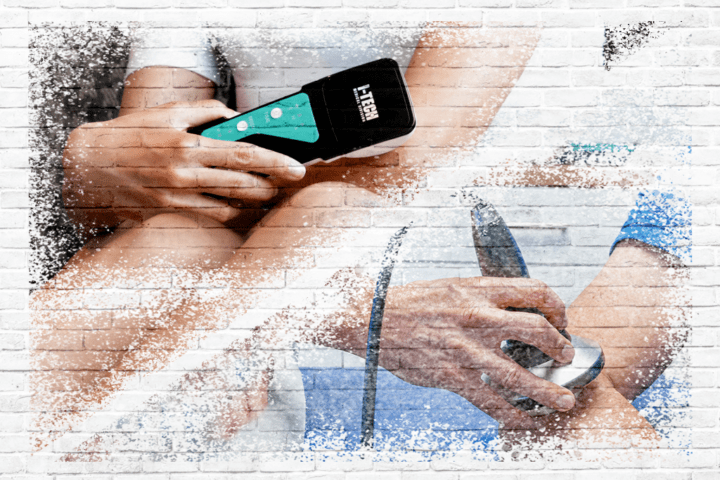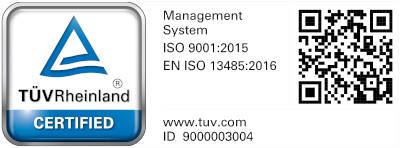Tendonitis, epicondylitis, lower back pain, carpal tunnel: how to treat them?
These pathologies can benefit from both the positive effects of the ultrasound therapy and those of shock waves. But when to choose one therapy over the other?
Between ultrasound and shockwave therapy, there are many differences, but don’t worry – by the end of this article, you will no longer be in any doubt!
What are shock waves?
Shock waves are high-energy acoustic waves that spread through tissue in a rapid and repeated sequence. Depending on their type, they are produced by specific generators or compressors, and are introduced into the body via an applicator.
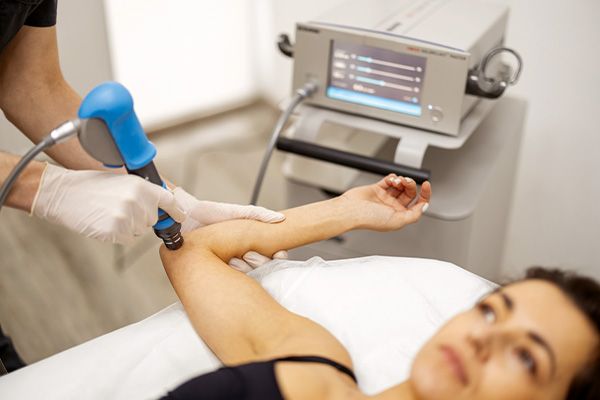
Shockwave therapy is used extensively in orthopaedics. In addition to treating numerous tendon and bone pathologies, it can also treat muscle-related disorders.
Focused and radial shock waves
The difference between radial and focused shock waves lies mainly in the procedure and the type of pathology being treated.
Focused shock waves, as the name suggests, can be focused and directed to reach deep tissue. That is why they are also used for the treatment of bone diseases. The procedure involves using applicators of soft and elastic consistency, so as to avoid injury.
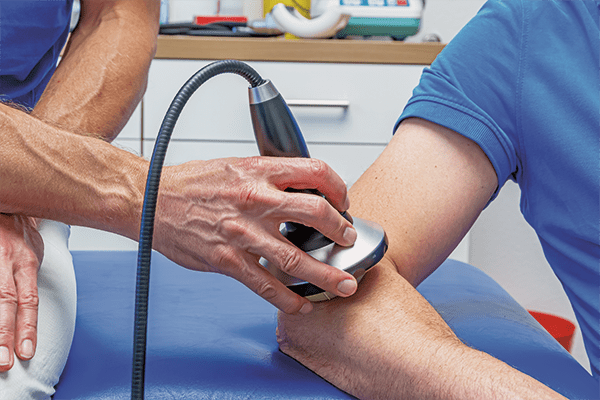
Radial (or ballistic) waves, on the other hand, are transmitted to the body tissues via a metal applicator, via direct tapping on the skin. During the session, the applicator can be moved to cover the entire body area. Radial shock waves propagate in different directions and retain their energy when they remain more at the surface. Generally, they penetrate about 1-3 cm.
Radial shock waves are ideal for treating trigger points, muscle contractures and tendinopathies.
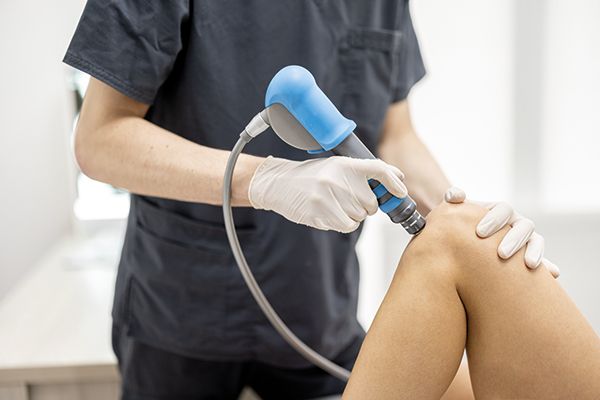
What is ultrasound therapy?
Ultrasound therapy is an instrumental physical therapy that is excellent for treating diseases of the musculoskeletal system. It uses sound waves that penetrate the soft tissues of the body, transferring energy. To facilitate the passage of sound waves, water-based conductive gel is applied during the treatment.
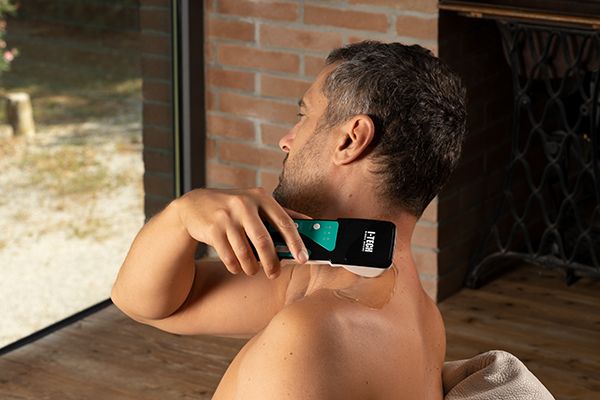
The sound waves generate micro-vibration within the tissue, which in turn, produces thermal energy. This energy increases the blood flow in the treated area, accelerating the healing of damaged tissue.
What is the difference between shock waves and ultrasound therapy?
The difference between shock waves and ultrasound is based on the delivery mode of the treatment, as well as the pathologies they can treat.
In the previous paragraphs, we have seen how the two therapies work. Now let’s get down to the specifics of intended use, contraindications, side effects and costs.
Shock waves are particularly indicated for the treatment of calcifications, thus, calcific tendinopathies (frozen shoulder), calcaneal spine and plantar fasciitis, particularly if calcific.
They also treat epicondylitis, lower back pain and carpal tunnel. These treatments can be performed with either focused or radial shock waves. However, radial shock waves are used more often – also for cellulite.
It should be noted that the shock waves are professional devices, so the therapy must be carried out in a medical practice.
The price for this device is around EUR 10,000 (a figure that may rise or fall depending on the features of the device and the technology used).
Speaking of a shock wave session, on the other hand, the cost can vary from 50 to 80 euro.
Typically, if treating soft tissue, a shock wave session lasts 10-15 minutes.
If you are wondering whether shock waves are bad for you, a distinction must be made. In general, radial shock waves are well tolerated by patients. Focused ones, on the other hand, can be painful.
There are some side effects that may occur after therapy.
They usually appear after 1-2 days and consist of: redness, swelling, pain, haematomas, red spots, skin lesions in case one has undergone cortisone therapy in the previous days.
They generally fade after 5-10 days and it is important not to repeat the treatment until they disappear.
Who cannot undergo shock wave therapy?
Similarly, it is necessary to pay attention to contraindications, the main ones of which include:
- wearers of implants (such as pacemakers)
- pregnant women
- subjects with deep vein thrombosis, phlebitis, varices, occlusive vascular disease and tumours.

Direct treatment of the carotid sinuses, cervical ganglion and heart should also be avoided. As well as areas above air-filled tissues (lungs), areas close to nerves and large vessels, the head and the spine.
Attention should be paid to this last point, especially when treating low back pain.
It is therefore always essential to consult your doctor before undergoing shock waves.
At this point you will ask yourself: "what are ultrasounds for?"
Ultrasound therapy effectively treats myofascial pain, muscle pain, carpal tunnel, venous and pressure ulcers, lower back pain, arthrosis, epicondylitis, epitrocleitis, tendonitis, cubital tunnel, lumbar stenosis and sciatica. It can also treat calcaneal spine but mainly with an anti-inflammatory effect.
A first difference immediately jumps out at you, namely, that ultrasound therapy can also treat neurological disorders. Another aspect to consider is the possibility of conveying active ingredients, thus enhancing the therapeutic effects, thanks to the technique of phonophoresis (or sonophoresis). Method not possible with shock waves.
Ultrasound therapy is also widely used in the beauty sector, not only to treat cellulite, but also for facial treatments and blemishes.
Another benefit of ultrasound therapy is the possibility of carrying out the therapy in the comfort of your home. This is because there are medical devices on the market that are also certified for home use. The price for this type of device ranges from around €200 to €350, while for devices designed for clinical practice, the price is around €1500.
An ultrasound session can last between 5 and 15 minutes depending on the pathology being treated.
The therapy does not produce any particular side effects, but it is nevertheless worth paying attention to contraindications, including the following: people with heart disease, serious cardiovascular problems, in a feverish state or with thrombophlebitis; people with tumours, tuberculosis or in an advanced state of osteoporosis; as well as pregnant women and wearers of metal implants may not undergo ultrasound therapy unless prescribed by their doctor.
The benefits of shock waves
Shock waves are a non-invasive therapeutic technique with significant clinical efficacy.
Their stimulating effect provides numerous benefits, including:
- anti-inflammatory effect,
- pain-relieving effect,
- improvement of local microcirculation,
- improvement of joint mobility,
- repair of damaged tissue.
They are often combined with other therapies, such as tecartherapy or ultrasound therapy, to achieve even better results.
The benefits of ultrasound
Ultrasound therapy allows you to recover your physical condition in just a few sessions.
It is a non-invasive physical therapy that promotes biostimulation and trophic action, relaxation of contracted muscles and rapid recovery from pain. It is excellent for reducing inflammation in the subacute or chronic phase, boosting oxygen and nutrient delivery to the tissues.
Its benefits make it an effective therapy for aesthetic problems such as blemishes, reactivating local blood flow and promoting the absorption of active ingredients. Similarly, it is very popular among athletes as it helps to recover quickly from pain and inflammation.
How to choose the right device for ultrasound therapy?
Now that we have outlined the main differences between the two therapies, you will certainly have noticed that some pathologies can be treated with both shock waves and ultrasound therapy.
If you have heard about shock waves and are considering a few sessions, but still have some doubts about it, we can tell you that ultrasound therapy is a viable alternative to shock waves.
However, we always advise you to consult your doctor before undergoing any treatment.
If your specialist has prescribed ultrasound therapy sessions and you are thinking of purchasing a device for home use, or if you have your own practice and are considering ultrasound therapy sessions, know that you will find all the information you need here.
Powersonic and Mio-Sonic are our certified medical devices for home therapy.
Both effectively treat pathologies affecting the musculoskeletal system. They can also be used for aesthetic purposes. With the added bonus of choosing where to do your therapy, thanks to Powersonic, the only battery-powered ultrasound device on the market!
I-Tech UT2 and I-Tech UE are our professional devices for clinical use.
Comprehensive devices that allow treatment to be tailored to the patient’s therapeutic needs, as well as combining two therapies (ultrasound and electrotherapy) to get the most out of the session – particularly with the I-Tech UE device.


